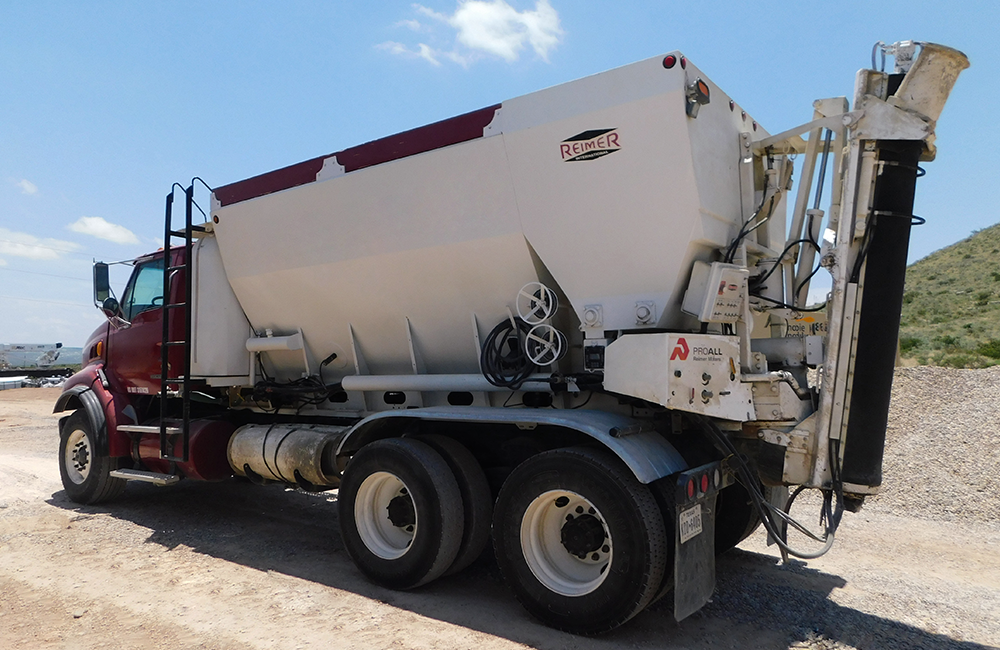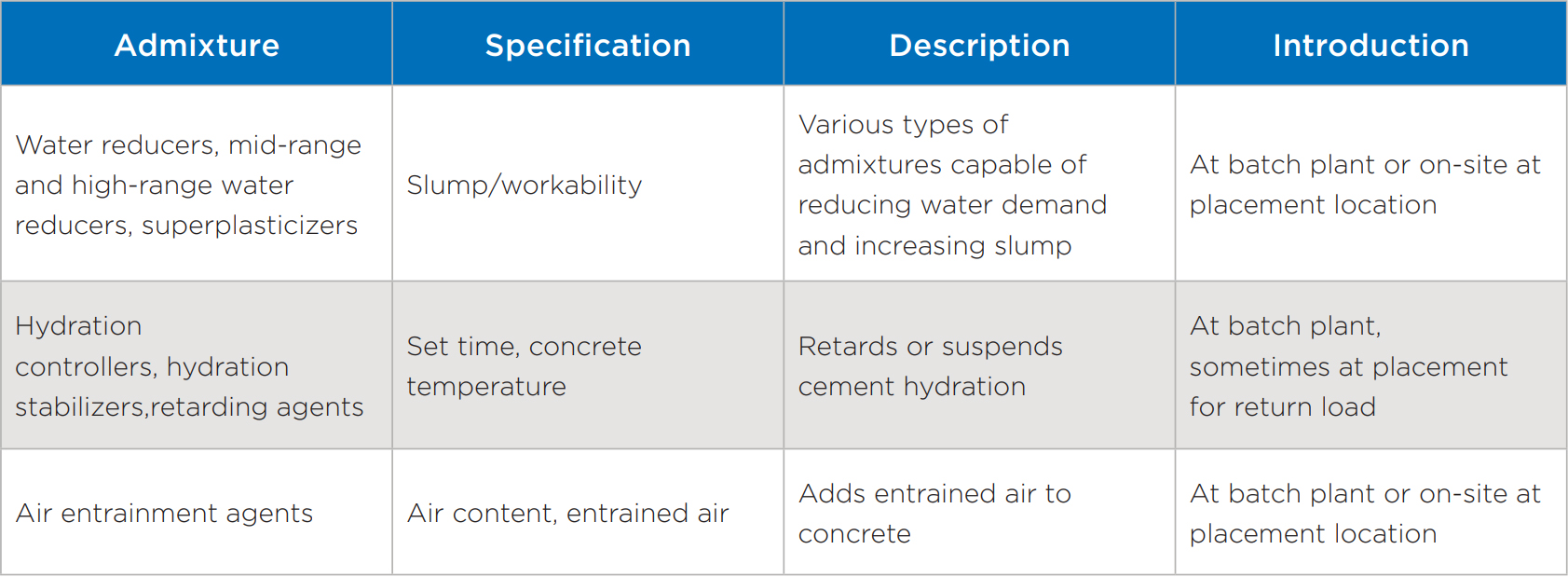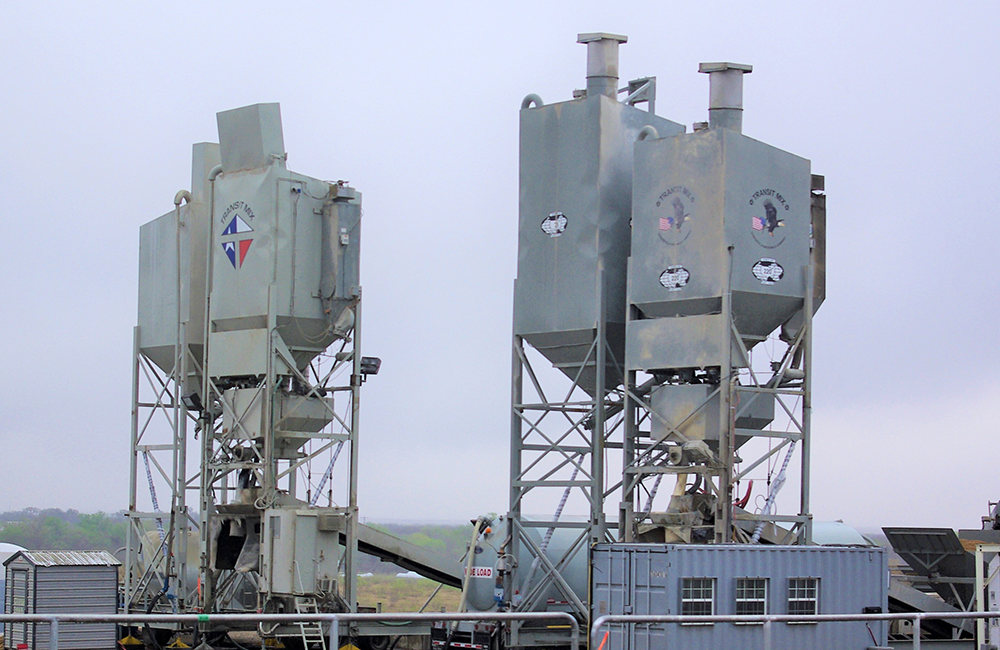Regions of the United States that are favorable to renewable generation growth typically have year-round sustained winds and sunny skies. However, these areas are often in remote locations with low population density and little infrastructure in place.
Transmission providers tasked with connecting these renewable generators to the grid often face logistical challenges to construct transmission lines and substations in remote locations. When a transmission line is constructed, engineers and constructors might find that the line traverses sparsely populated areas that could be hours away from concrete suppliers.
Concrete supply in remote locations can be a significant logistical hurdle, but measures can be taken to mitigate these logistical challenges. Upfront planning for concrete supply is an important part of the process to design and execute a project with high-quality and timely concrete construction.
In these situations, several concrete supply options can be considered. Traditional construction has used ready-mix batch plants coupled with truck-mounted drum mixers for decades. This concrete supply method is the most familiar to engineers and constructors. Mobile batch plants are used less frequently but offer the familiarity of a ready-mix plant and truck delivery, with the benefit of being located at or near the project site. An alternative supply option, volumetric batching and supply, is gaining acceptance in the utility industry and offers some attractive advantages over more traditional methods.
VOLUMETRIC BATCHING
TYPICAL EQUIPMENT ARRANGEMENT
A mobile volumetric concrete mixer is a truck- or trailer-mounted concrete batch plant. The truck or trailer has a variety of tanks and bins that hold the necessary constituents to make typical concrete (e.g., sand, coarse aggregate, cement, water and admixtures). These tanks and bins are sized for the rated volume capacity of the mixer.
The volumetric concrete mixer is similar in many ways to a typical batch plant, but it has been miniaturized for mobility.
Here’s how a mobile mixer works: Coarse aggregate and sand are delivered onto the conveyor belt through flow control gates at the rear of each bin, followed by the introduction of dry cement near the back of the truck. Water and admixtures are introduced to the dry constituents just as the materials reach the mixing bowl above the mixing auger. Typically, there is a control panel at the rear of the truck that allows the operator to monitor the process and log data for record-keeping purposes. In newer trucks, the computer itself controls the gates and the valves for the constituent materials in order to deliver a precise, preprogrammed mix design. This innovation in the equipment reduces human error and increases the quality and consistency of the mix design. Older models have gates that must be set manually prior to operation of the mixer.
Some limitations to the concrete mix design and available constituents are a direct result of the physical configuration of the equipment. Typically, there is a single bin for the cementitious material. The bin is sealed to prevent moisture from compromising the cement. This single cementitious material bin makes it more difficult to employ a mix design that calls for supplementary cementitious material such as fly ash or ground granulated blast furnace slag. It is possible to have a blended cement in the hopper, but this would need to be carefully considered when ordering material and calibrating the volumetric equipment.
Common names for continuous volumetric mixers (per the Volumetric Mixer Manufacturer Bureau) include:
- Concrete mobiles
- Mobile mixers
- Shake and bake trucks
VOLUMETRIC BATCHING VS. BATCHING BY WEIGHT
The accurate proportioning of constituents for a mix design is imperative to producing concrete that achieves the proper strength and durability. It is important to understand the inherent differences in the methodologies available to batch concrete for a modern construction project. These differences, along with the associated advantages and disadvantages of the delivery method, are important data for the engineering and construction team to consider when planning and executing a substation or transmission line project.
Volumetric batching is accomplished by measuring and dispensing the volume of each constituent material, rather than the weight of the materials. Those constituent materials are discharged from their compartments by gates and metered valves into a mixing auger. If there is a continuous supply of material, the volumetric mixer can produce concrete. Problems can arise when constituent material becomes damp, causing bulking or clumping that can complicate the volume measurement. Volumetric batching equipment must be properly calibrated to deliver the precise volume of each material necessary to produce the desired concrete mix. Anecdotally, the most basic mix design is volume-based: one shovel of cement, two shovels of sand, and three shovels of coarse aggregate.
Weigh batching, which is the typical approach for a ready-mix batch plant, provides greater accuracy and is a simpler process for larger volumes of concrete. There are a series of scales, mechanical or electronic, that accurately weigh the materials being combined to batch the mix design. In modern batch plants, the ready-mix batch plant equipment can account for the presence of moisture in constituents such as the sand by automatically measuring the moisture content. Using this data, the amount of water added for the mix design is adjusted to arrive at the correct water-to-cementitious material ratio. This functionality is not present in mobile volumetric batching equipment.

FIGURE 1: Volumetric concrete truck.
ADVANTAGES OF VOLUMETRIC CONCRETE SUPPLY
There are many advantages that come from employing a volumetric concrete mixer on a project. These should be considered when evaluating the concrete supply plan for a project with the contractor:
- On-site concrete production for foundations. This mitigates the transport time concern associated with projects in rural and difficult-to-reach areas.
- Dedicated, uninterrupted concrete supply. Equipment and materials are set up and dedicated specifically for a project. In high-demand regions, it is becoming increasingly difficult to guarantee concrete availability.
- Reduced concrete waste. On-demand production limits the need for concrete washout areas and may have a positive environmental effect, given the considerations for certain project locations. Traditional ready-mix plants may require a minimum order for a truck.
- Specialty concrete mix capability. Concrete may be mixed with coloring, fiber reinforcement or other admixtures.
- Reduced concrete costs. According to Cemen Tech of Indianola, Iowa, concrete costs may be reduced by about 40%, primarily from the prevention of overordering.
DISADVANTAGES OF VOLUMETRIC CONCRETE SUPPLY
Disadvantages for volumetric mixers that should be considered in the concrete supply for a project:
- Less consistency. Concrete produced by volumetric mixers has been shown to have higher variability than the concrete produced by a ready-mix plant. Vibrations caused when trucks hit rocks and potholes during travel to and from the job site affect the dispensing equipment. This is one of the primary drivers behind the need for calibration and testing on a frequent basis.
- More frequent strength testing. More testing is required per ASTM International’s C685 standard (Standard Specification for Concrete Made by Volumetric Bathing and Continuous Mixing) to see that a consistent, high-quality material is being produced.
- Small volume of concrete production. A relatively small volume of concrete can be produced by a single truck, based on the capacity of the constituent material compartments. Typical capacity ranges from 3 to 12 cubic yards, with production rates of 30 to 90 cubic yards per hour.
- On-site storage of constituent materials. For some projects, a stockpile of the constituent materials would be needed on-site or in a nearby staging yard to facilitate continuous production of concrete. That would also require equipment that can load the material into the volumetric truck or trailer. Some concrete suppliers elect to use multiple trucks, which are stocked at the supplier’s facility.
CALIBRATION AND QUALITY CONTROL
Calibration of a volumetric truck is critical to produce consistent concrete. The trucks and trailers are subjected to forces during transport and use that can affect the accuracy of the dispensing equipment. The ASTM C685 standard recommends calibration and mixer efficiency tests be conducted at least once every six months.
Increased strength-testing frequency is another tool used to verify the quality of the material being produced by volumetric or continuous mixers. ASTM C685 recommends that strength tests be taken for each 25 cubic yards of concrete. The increased frequency of testing is to combat the increased variability that can be experienced with volumetrically batched concrete being produced from a mobile truck or trailer.
Another important aspect affecting the quality of the concrete is the personnel operating the equipment. The operator should be the person on the job site who is most familiar with that piece of equipment and capable of identifying problems. The American Concrete Institute’s Guide for Use of Volumetric-Measuring and Continuous-Mixing Concrete Equipment describes the minimum qualifications for the operator of a volumetric batching truck. It suggests the operator should have training and certification from the equipment manufacturer as well as a minimum of four weeks of on-the-job training with qualified personnel.
READY-MIX BATCHING
TYPICAL EQUIPMENT ARRANGEMENT
A traditional concrete ready-mix facility is generally a permanent stationary facility with a weigh batcher, aggregate storage pits/bins, silos for cementitious materials, washouts, and a control building. These facilities receive a constant supply of material as needed to meet the concrete supply demands.
These plants are often staffed by a small team consisting of a plant manager, loader-operators and maintenance personnel. Additionally, it is common for larger suppliers to have dedicated quality control personnel reviewing the site, equipment and batching procedures to meet criteria set by programs such as the National Ready Mixed Concrete Association (NRMCA) Plant Certification. Plants that go through the NRMCA Plant Certification program have scales calibrated per ASTM C94 requirements, which is ±0.15% of the scale capacity or ±0.4% of the applied test load. Accuracy of a certified weigh batching ready-mix facility is often very good.
Traditional ready-mix facilities often have a wide range of mix designs available because of larger storage capabilities. Most will have multiple coarse aggregate sizes available; different types of supplementary cementitious materials (SCMs) such as Class C or F fly ash; multiple admixture containers; and connection to a potable water source. Also, these facilities often stage and store concrete mixer trucks.
The aggregates are loaded onto conveyors, which feed the bins. All dry material is measured on calibrated scales to determine the exact weight being added to the mix. Concrete constituents are added via computer-controlled sequencing. The mixing process occurs in transit mixer trucks unless the batch plant employs a central mixing unit. Central mixing units typically are not used for long-haul concrete placements. Finally, a batch ticket indicates the target/actual mix design material amounts.
EXTENDED-HAUL TECHNIQUES
A typical concrete load batched from a ready-mix facility will only allow up to two hours for delivery and placement of concrete before it starts to set or lose enough workability to put it outside of specifications. Other factors such as concrete temperature and air also might be out of range.
Ready-mix concrete can be delivered over a long distance or an extended duration, but it requires pre-planning, trial batches, an accommodating mix design and proper sequencing. Slump, concrete temperature and air content are all affected as time progresses. Slump, as a measure of concrete’s workability, is often controlled by water, water-reducing agents, high-range water reducers or superplasticizers. Each of the admixtures is time sensitive and wears off over time.
Controlling the cement hydration is critical for ready-mix concrete. Admixtures are available to either slow or suspend cement hydration. These are often referred to as retarding agents or hydration controllers. Hydration controllers put the concrete to “sleep,” preventing hydration. The dosage will affect the duration. Activators can be utilized to “wake” the concrete and initiate hydration.
Air content drops over time as concrete is mixed or agitated. Field addition of air entrainment admixtures is a common practice to raise air content up to specification.

FIGURE 2: Constituent materials in the volumetric concrete truck’s conveyor.

FIGURE 3: Typical concrete admixtures.
Concrete temperature is also key to controlling cement hydration and slump loss. Lower concrete temperatures allow for less water demand to hold the desired slump. Methods of controlling concrete temperature include pre-wetting/cooling aggregate stockpiles and using chilled water, ice or liquid nitrogen. Cooling of stockpiles and chilled water are the most common means to control temperature. Ice is also common, but it is more difficult to maintain a uniform mixture. Liquid nitrogen is another option, but this requires retrofitting of the batching facility and additional safety measures, training and personal protective equipment (PPE). Due to the high cost of liquid nitrogen cooling, it is often reserved for hot weather concreting or projects large enough to justify the additional cost of retrofitting the facility.
With a suite of admixtures and agents available to modify the behavior of concrete, performing field testing and trial batches is paramount. Trial batches give vital data regarding the behavior of the mix design and confirm admixture compatibility.
Slump loss testing is an important procedure for determining the feasibility of long-haul concrete placements for any given mix design. Slump loss testing is ideally done under the same conditions as the expected placement. After the trial batch is mixed, it is tested for slump, air content and temperature at regular intervals (generally every 15-30 minutes). These values are recorded until a predetermined slump value is reached. Sudden rises in temperature often indicate that retarding agents or hydration controllers are wearing off. A slow decrease in slump followed by a sudden drop indicates that the water-reducing agents are wearing off. Generally, concrete with entrained air will have a continual drop in air content during the test as the drum revolves at agitation speed.
Slump loss testing also can provide insight on admixture sequencing, such as whether certain admixtures should be added at the plant when the concrete is batched or in the field after transit. For instance, it is common to field dose a high-range water reducer on-site to increase the slump before placement. Methods like this may mitigate concerns of concrete being outside of placement specifications once it arrives on-site.
This testing is a common procedure throughout the United States, though as of this writing no ASTM standard has been developed. Most design professionals rely on state departments of transportation, which often have slump loss testing procedures. For instance, both the Texas Department of Transportation (TxDOT) and Florida Department of Transportation (FDOT) have developed slump loss testing procedures that could be used as guidelines. Both DOTs are among the largest concrete users within the U.S. Their tests have provided reliable predictors as to a concrete mix design’s performance for long-haul concrete scenarios.
ADVANTAGES OF READY-MIX CONCRETE SUPPLY
Using a supply of ready-mix concrete can deliver advantages, including:
- Most facilities use calibrated weigh batching equipment, which promotes high accuracy.
- There is a wide range of available admixtures to aid in long-haul concrete delivery.
- There are more mix design options and the use of SCMs is easier.
- Many facilities have capabilities of ice or even liquid nitrogen for cooling on high-temperature days.
DISADVANTAGES OF READY-MIX CONCRETE SUPPLY
Using a supply of ready-mix concrete also can come with disadvantages. Among them:
- More concrete waste, as customers tend to overorder concrete to make sure long-haul placements don’t require another callout.
- Concrete delay and interruption are more common with broken-down equipment, underordering or traffic delays. This can lead to costly repairs or cold joints.
- Additional admixtures can be cost-prohibitive, depending on the project’s budget.
PORTABLE BATCH PLANT

FIGURE 4: Portable batch plant.
Some projects are large enough to warrant having a portable batch plant brought to the site temporarily so that extended-haul concrete is not required. These facilities share much in common with traditional ready-mix facilities. Many permanent facilities are made of portable-type equipment.
These facilities generally operate on weigh batching techniques, so accuracy is typically good. Portable batch plants may face challenges such as increased material supply costs, lack of potable water sources, and additional permitting, such as for dust control.
Supplier quality control may differ, as it is not a permanent facility. It is a good practice for a plant inspection to take place anyway, such as the NRMCA Plant Certification, which requires a qualified professional to inspect the equipment according to NRMCA guidelines. Since these plants are mobile, scales and equipment may be subject to vibration or damage, and recalibration may be required.
CONCLUSION
Concrete supply presents challenges in material science, logistics and execution, even with readily available materials and suppliers. When a project is in a remote location with little infrastructure, these challenges are compounded. Whether a traditional batch plant or volumetric batching from a mobile truck is to be used, it is important to understand the differences to achieve proper planning, testing and implementation. Knowledge of the various concrete supply methods gives the engineer and constructor additional tools to execute the project and successfully construct a high-quality concrete foundation.